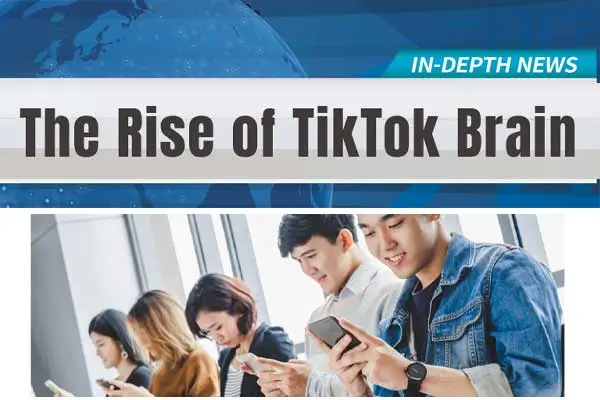 https://www.ivy.com.tw/newsLette ... 2023091115443346699
https://www.ivy.com.tw/newsLette ... 2023091115443346699
�����ݵu�v�� �p�߬V�u�ݭ����v The Rise of TikTok Brain
The Rise of TikTok Brain
#�߲z #�ɨ� #�y��ɩ|
1/10 �ѪR�^�y
�@�� Analytical Editors
�\Ū�ɶ� 5����
ť���� ť��Ū
���Ϥ�X�B:
https://www.ivy.com.tw/newsLetter/analysis_cont/2023091115443346699
MP3:
�����ݵu�v�� �p�߬V�u�ݭ����v The Rise of TikTok Brain
�b�~���H�������t�Ǽ��}�Ӫ��̷s����C�����ε{���O TikTok
�ؿ� / More to Learn / ����½Ķ(& ����)
The latest social media app to spread like wildfire among young people is TikTok. This app works by people creating and sharing short videos that usually last under a minute. The videos posted often cover various topics like dance challenges, fashion trends, prank videos, or even news updates. While this might seem like just another harmless social media app, new research shows that TikTok can negatively affect people��s attention spans.
Some studies have recently discovered that apps like TikTok affect people��s brains. Specifically, it has altered how our brains release dopamine. Dopamine is often called the ��feel-good�� hormone because it produces feelings of pleasure that can motivate people to do more of an activity. It is a neurotransmitter that our brains release as a reward when we do undertakings such as eating a tasty meal, winning a race, or watching a funny video. So, when people watch short, 30-second videos over and over, their brains release more dopamine with each video.
If people continually repeat this cycle over a period of time, it can eventually rewire our brains to expect instant gratification. When this isn��t met, people will shift their attention to something new. Furthermore, it reduces our ability to delay gratification and focus on things for long periods of time. This issue can be especially problematic in teenagers whose brains are still developing and can lead to addictive tendencies.
To prevent the development of TikTok brain in their children, parents are advised to limit the amount of screen time their children have. Parents should also set good examples by turning off their phones and fully engaging with their children during conversations.
1. According to the passage, which of the following is NOT true about TikTok?
(A) It has rapidly gained popularity among the youth.
(B) It never covers any topics other than dance challenges.
(C) It enables users to view, produce, and distribute brief videos online.
(D) It may harmfully impact individuals'ability to focus for extended periods.
2. Why is dopamine often referred to as the ��feel-good�� hormone?
(A) It is more common in teenagers.
(B) It creates sensations of delight.
(C) It is used to stabilize people��s emotions.
(D) It aids in the length of time a person can concentrate.
3.According to the passage, what can parents do to keep their children from developing TikTok brain?
(A) Ask their children to switch off their phones.
(B) Ban all screen time completely for their children.
(C) Avoid face-to-face interactions with their children.
(D) Set restrictions on how long their children look at the screen.
����: 1 B 2 B 3 D
��r���y��z
Words in Use
��
specifically [sp����s��f��k!��]
adv. �ר�A�S�O�a
��
alter [����ltɚ]
vt. �ק�]��A�^
vt. & vi. ����
��
update [ʌp��det]
vt. �ϧ�s�F���K�K���ѳ̷s����
n. ��s�]�����^
��
shift [����ft]
.vt. �ಾ�A����
n. ���Z
��
motivate [��motə͵vet]
.vt. �P�ϡA�E�o
��
hormone [��h��rmon]
n. �����X
��
span [spæn]
n. . �@�q�ɶ�
vt. �]�ɶ��^����A�e��F�]�A
��
continually [kən��t��nj��əl��]
adv. ����a�A�����_�a
��
prank [pr�k]
n. �c�@�@
��
problematic [͵prɑblə��mæt��k]
a. �R�����D��
��
dopamine [��dopə͵min]
n. ���g�Ǿɪ���
��
undertaking [͵ʌndɚ��tek����]
n. �u�@�A����
��
rewire [ri��wa��r]
vt. ����]�j���^�F���s�ˡ��t�u
��
gratification [͵grætəfə��ke��ən]
n. ����
Practical Phrases
��
spread like wildfire ���t�a�Ƕ}��
The rumor spread like wildfire.
�����ܧִN�����}�ӡC
��
set an example (for sb) �]���Y�H�^��ߤ@�Ӻ]��
Teachers should set a good example for students.
�Ѯv�����ǥ;�ߤ@�Ӧn�]�ˡC
��
over and over ���Цa�A�@�A�a�A��
The audience chanted the name of the singer over and over.
�[���@���S�@���a���ۨ��Ӻq�⪺�W�r�C
��
engage with �P⋯⋯��y
Engaging with people of different backgrounds can be beneficial.
�P���P�I�����H��y�O���q���C
��
screen time �]�ݹq���B�q���B��������^�ù��ɶ�
More to Learn
addictive a. �W�}��
• Morphine may alleviate your pain, but it is physically addictive.
�ܰؤ]�\�i�H��A���h�W�A���b�Ͳz�W�o�|�W�}�C
�r�� -ive ���u���K�K�ʽ誺�v�A�H�U���дX�Ө�L�`������r�J
a. defensive a. ���m��
• Don't be so defensive. I didn't mean that in a bad way.
���äߧO����j�C�ڨ��èS���c�N�C
b. offensive a. �����ʪ��F�_�Ǫ�
• You should bite your tongue if you think you're going to say something offensive.
���Aı�o�A�����ܷ|�_�Ǩ�O�H�ɡA�A�N���ӧԦ������C
��bite one's tongue�@�@�]�Y�H�^�j�Ԧ�����
c. excessive a. �L�ת�
• Excessive drinking is harmful to your health.
���s�L�q���`���d�C
d. narrative a. �Ԩƪ�
• Jane composed a narrative poem that depicted the beauty of nature.
�p�üg�F�@���yø�j�۵M�������ԨƸ֡C
e. massive a. ���j��
• A massive sign just fell off the building.
�@�ӥ��j���۵P��q���ɫؿv���W���F�U�ӡC
f. progressive a. �]����Q�����^�i�B�������i��
• The governor has adopted a progressive posture towards same-sex marriage.
�Ӧ{����P�ʱB�ñĨ��F���i���߳��C
����½Ķ(& ����)
�����ݵu�v���@�p�߬V�u�ݭ����v
�b�~���H�������t�Ǽ��}�Ӫ��̷s����C�����ε{���OTikTok�C�o�����ε{�����B�@�覡�O�H�̻s�@�ä��ɳq�`���W�L�@�������u�v���C�o�����v���`�[�\�U�إD�D�A�p�R�ЬD�ԡB�ɩ|��y�B�c�@�@�v���A�άƦܬO�s�D�̷s�����C���M�o�ݦ��u�O�t�@�ӵL�`������C�����ε{���A���s����s�����ATikTok �|��H�̪��`�N�O�ɶ����ͭt���v�T�C
�@�Ǭ�s�̪�o�{�A���O TikTok �o�������ε{���|�v�T�H�̪��j���C����ӻ��A�����ܤF�ڭ̤j������h���i���覡�C�h���i�q�`�Q�٬��u�ϤH�r�����v�����X�A�]�����ಣ�ʹr���P�A�P�ϤH�̱q�Ƨ�h�Y�@�����ʡC�h���i�O�@�د��g�Ǿɪ���A���ڭ̰��@�ǨƱ��� �w�w ��p�Y�@�y�i�f���\�I�BĹ�o�@�����ɩ��[�ݤ@�q���쪺�v�� �w�w �j���N�|����h���i�@�����y�C�]���A���H�̤@���S�@���a�[�ݤT�Q�����u�v���ɡA��j���N�|�H�ۨC�q�v�������h���h���i�C
�p�G�H�̦b�@�q�ɶ������_���Ƴo�˪��`���A�̲״N�|����ڭ̪��j���A����i�����ݧY�ɺ������ߺD�C�@���o����o�اY�ɪ������A�H�̴N�|��`�N�O���s���ƪ��W�C���~�A�o���ٷ|���C�ڭ̩����P�M���ɶ������`�N�O����O�C���j�����b�o�|���C�֦~�ӻ��A�o�Ӱ��D�ר��Y���A�B�i��|�ɭP���}�ɦV�C
������Ĥl�o�i�X�ݭ����]TikTok brain�^�A��ij�a������Ĥl�ݿù����ɶ��C�a�������b�P�Ĥl��ͮ���������ç�����J�A�H��ߨ}�n�]�ˡC
1. �ھڥ���A�H�U�������� TikTok ���ԭz�O�����T���H
(A) ���b�~���H�������t�y��_�ӡC
(B) ���q���[�\���F�R�ЬD�Ԥ��~������D�D�C
(C) �����Τ����u�W�[�ݡB�s�@�M�o�e�u�v���C
(D) ���i��|��ӤH���ɶ������`�N�O����O���ͦ��`�v�T�C
2. ������h���i�`�Q�٬��u�ϤH�r�����v�����X�H
(A) ���b�C�֦~���W�`���C
(B) ���ಣ�ʹr�����Pı�C
(C) ���Ω�í�w�H�̪������C
(D) �����@�ӤH�����`�N�O���ɶ����צ������U�C
3. �ھڥ���A�����i�H���Ǥ���Ө���Ĥl�o�i�X�ݭ����H
(A) �n�D�Ĥl��������C
(B) �����T��Ĥl�ݿù����ɶ��C
(C) �קK�P�Ĥl���ﭱ��y�C
(D) ����Ĥl�ݿù����ɪ��C